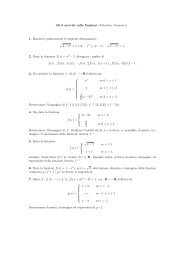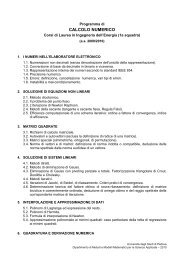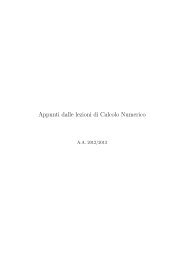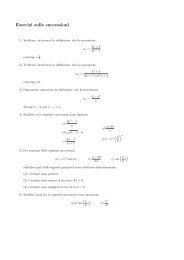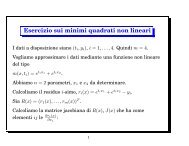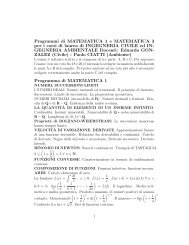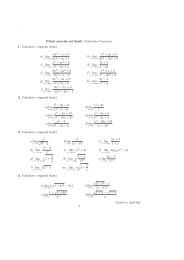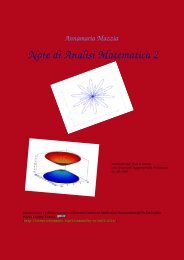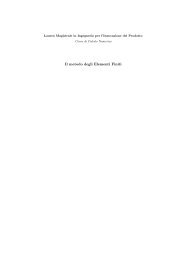Appunti di Calcolo Numerico - Esercizi e Dispense - Università degli ...
Appunti di Calcolo Numerico - Esercizi e Dispense - Università degli ...
Appunti di Calcolo Numerico - Esercizi e Dispense - Università degli ...
Create successful ePaper yourself
Turn your PDF publications into a flip-book with our unique Google optimized e-Paper software.
11. DIFFERENZIAZIONE NUMERICA ED EQUAZIONI ALLE DERIVATE ORDINARIE<br />
Per verificare che il metodo converge stu<strong>di</strong>amo il limite<br />
lim<br />
h→0<br />
i→+∞<br />
⎡<br />
( ) 2 − hλ i ( ) 1 ⎤<br />
⎢ 2 − hλ<br />
= ⎣<br />
h ⎥<br />
⎦<br />
2 + hλ 2 + hλ<br />
i h<br />
y i . Partiamo dalla relazione<br />
⎡<br />
( ) 1 ⎤t<br />
⎢ 2 − hλ<br />
= ⎣<br />
h ⎥<br />
⎦<br />
2 + hλ<br />
Ma<br />
( 2 − hλ<br />
2 + hλ<br />
) 1 1 2 − hλ<br />
ln(<br />
h = e h 2 + hλ )<br />
Nel fare il limite per h → 0 e i → +∞ della quantità che si trova all’esponente, applichiamo l’Hôpital e<br />
ricor<strong>di</strong>amo che la derivata <strong>di</strong> 2 − hλ −λ(2 + hλ) − (2 − hλ)λ<br />
vale<br />
2 + hλ (2 + hλ) 2 = −4λ<br />
(2 + hλ) 2 :<br />
Quin<strong>di</strong><br />
lim<br />
h→0<br />
i→+∞<br />
lim<br />
h→0<br />
i→+∞<br />
ln( 2 − hλ<br />
2 + hλ )<br />
h<br />
y i = lim<br />
La convergenza è provata.<br />
h→0<br />
i→+∞<br />
= lim<br />
h→0<br />
i→+∞<br />
( 2 − hλ<br />
y 0<br />
2 + hλ<br />
2 + hλ −4λ<br />
2 − hλ (2 + hλ) 2 = lim −4λ<br />
h→0 (2 + hλ)(2 − hλ) = −λ<br />
) i<br />
= lim<br />
h→0<br />
i→+∞<br />
i→+∞<br />
⎡<br />
( ) 1 ⎤<br />
⎢ 2 − hλ<br />
y 0 ⎣<br />
h ⎥<br />
⎦<br />
2 + hλ<br />
i h<br />
= y 0 e −tλ = y(t)<br />
11.9.6 Stabilità <strong>di</strong> Crank-Nicolson<br />
( ) 2 − λh i<br />
Per la stabilità, si vede che la soluzione numerica è y i = y 0 . Per i → +∞, qualunque sia il valore<br />
2 + λh<br />
( ) 2 − λh i<br />
<strong>di</strong> h, la soluzione tende a zero in quanto lim i→+∞ = 0. Il metodo è incon<strong>di</strong>zionatamente stabile.<br />
2 + λh<br />
11.9.7 Sulla stabilità<br />
La stabilità <strong>di</strong> questi meto<strong>di</strong> la si può verificare anche considerando <strong>di</strong>rettamente l’errore ɛ i , <strong>di</strong>mostrando<br />
che gli errori al passo i e al passo i +1 verificano la stessa relazione che hanno y i+1 e y i e mostrando che l’errore<br />
rimane limitato sotto con<strong>di</strong>zione per Eulero esplicito mentre è incon<strong>di</strong>zionatamente stabile per gli altri<br />
meto<strong>di</strong>. In Figura 11.3 si vede come il metodo <strong>di</strong> Eulero esplicito sia stabile sotto con<strong>di</strong>zione mentre i meto<strong>di</strong><br />
<strong>di</strong> Eulero implicito e Crank-Nicolson sono stabili qualunque passo <strong>di</strong> <strong>di</strong>scretizzazione venga utilizzato.<br />
180



